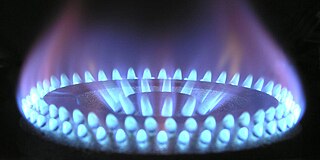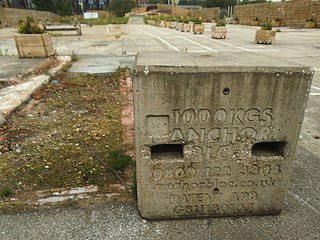Related Research Articles
The British thermal unit (Btu) is a measure of heat, which is a form of energy. It was originally defined as the amount of heat required to raise the temperature of one pound of water by one degree Fahrenheit. It is also part of the United States customary units. The SI unit for energy is the joule (J); one Btu equals about 1,055 J.

Natural gas is a naturally occurring mixture of gaseous hydrocarbons consisting primarily of methane (97%) in addition to various smaller amounts of other higher alkanes. Low levels of trace gases like carbon dioxide, nitrogen, hydrogen sulfide, and helium are also usually present. Methane is colorless and odorless, and the second largest greenhouse gas contributor to global climate change after carbon dioxide. Because natural gas is odorless, odorizers such as mercaptan are commonly added to it for safety so that leaks can be readily detected.

Ton is any of several units of measure of mass, volume or force. It has a long history and has acquired several meanings and uses.

The tonne is a unit of mass equal to 1,000 kilograms. It is a non-SI unit accepted for use with SI. It is also referred to as a metric ton in the United States to distinguish it from the non-metric units of the short ton and the long ton. It is equivalent to approximately 2,204.6 pounds, 1.102 short tons, and 0.984 long tons. The official SI unit is the megagram (Mg), a less common way to express the same amount.
The therm is a non-SI unit of heat energy equal to 100,000 British thermal units (BTU), and approximately 105 megajoules, 29.3 kilowatt-hours, 25,200 kilocalories and 25.2 thermies. One therm is the energy content of approximately 100 cubic feet of natural gas at standard temperature and pressure. However, the BTU is not standardised worldwide, with slightly different values in the EU, UK, and United States, meaning that the energy content of the therm also varies by territory.

A barrel is one of several units of volume applied in various contexts; there are dry barrels, fluid barrels, oil barrels, and so forth. For historical reasons the volumes of some barrel units are roughly double the volumes of others; volumes in common use range approximately from 100 to 200 litres. In many connections the term drum is used almost interchangeably with barrel.

North Sea oil is a mixture of hydrocarbons, comprising liquid petroleum and natural gas, produced from petroleum reservoirs beneath the North Sea.
The tonne of oil equivalent (toe) is a unit of energy defined as the amount of energy released by burning one tonne of crude oil. It is approximately 42 gigajoules or 11.630 megawatt-hours, although as different crude oils have different calorific values, the exact value is defined by convention; several slightly different definitions exist. The toe is sometimes used for large amounts of energy.
The following outline is provided as an overview of and topical guide to energy:

Petronet LNG Limited is an Indian oil and gas company formed by the Government of India to import liquefied natural gas (LNG) and set up LNG terminals in the country. It is a joint venture company promoted by the Gas Authority of India Limited (GAIL), Oil and Natural Gas Corporation Limited (ONGC), Indian Oil Corporation Limited (IOC) and Bharat Petroleum Corporation Limited (BPCL). Petronet LNG Limited, one of the companies in the Indian energy sector, has set up the country's first LNG receiving and regasification terminal in Dahej, Gujarat, and another terminal in Kochi, Kerala. While the Dahej terminal has a nominal capacity of 17.5 million tonnes per year, the Kochi terminal has a capacity of 5 million tonnes per year. Plans to build a third LNG terminal in Gangavaram, Andhra Pradesh were dropped in October 2019.
Energy is defined via work, so the SI unit of energy is the same as the unit of work – the joule (J), named in honour of James Prescott Joule and his experiments on the mechanical equivalent of heat. In slightly more fundamental terms, 1 joule is equal to 1 newton metre and, in terms of SI base units
The South Pars/North Dome field is a natural-gas condensate field located in the Persian Gulf. It is by far the world's largest natural gas field, with ownership of the field shared between Iran and Qatar. According to the International Energy Agency (IEA), the field holds an estimated 1,800 trillion cubic feet of in-situ natural gas and some 50 billion barrels of natural gas condensates. On the list of natural gas fields it has almost as much recoverable reserves as all the other fields combined. It has significant geostrategic influence.

QatarEnergy, formerly Qatar Petroleum (QP), is a state owned petroleum company of Qatar. The company operates all oil and gas activities in Qatar, including exploration, production, refining, transport, and storage. The President & CEO is Saad Sherida al-Kaabi, Minister of State for Energy Affairs. The company's operations are directly linked with state planning agencies, regulatory authorities, and policy making bodies. Together, revenues from oil and natural gas amount to 60% of the country's GDP. As of 2018 it was the third largest oil company in the world by oil and gas reserves. In 2022, the company had total revenues of US$52bn, a net income of US42.4bn, and total assets of US$162bn. In 2021, QatarEnergy was the fifth largest gas company in the world.
Oil shale reserves refers to oil shale resources that are economically recoverable under current economic conditions and technological abilities. Oil shale deposits range from small presently economically unrecoverable to large potentially recoverable resources. Defining oil shale reserves is difficult, as the chemical composition of different oil shales, as well as their kerogen content and extraction technologies, vary significantly. The economic feasibility of oil shale extraction is highly dependent on the price of conventional oil; if the price of crude oil per barrel is less than the production price per barrel of oil shale, it is uneconomic.

The Bend Arch–Fort Worth Basin Province is a major petroleum producing geological system which is primarily located in North Central Texas and southwestern Oklahoma. It is officially designated by the United States Geological Survey (USGS) as Province 045 and classified as the Barnett-Paleozoic Total Petroleum System (TPS).
As of 2017, Azerbaijan produced a range of metals and industrial minerals, including aluminum, bentonite, copper, gold, iodine, limestone, silver, and steel.

Within the petroleum industry, proven crude oil reserves in the United States were 44.4 billion barrels (7.06×109 m3) of crude oil as of the end of 2021, excluding the Strategic Petroleum Reserve.
Although there are numerous oil companies operating in Canada, as of 2009, the majority of production, refining and marketing was done by fewer than 20 of them. According to the 2013 edition of Forbes Global 2000, canoils.com and any other list that emphasizes market capitalization and revenue when sizing up companies, as of March 31, 2014 these are the largest Canada-based oil and gas companies.

Pearl Petroleum is a five-company consortium consisting of two Middle Eastern oil and gas companies, Dana Gas and Crescent Petroleum, which together are the operator of the Kurdistan Gas Project, in partnership with three major European energy companies: OMV, MOL, and RWE. Pearl Petroleum produces and develops natural gas assets in the Kurdistan Region of Iraq.
References
- ↑ IRS publication
- ↑ Table AR-1 USGS World Petroleum Assessment 2000, Description and results, USGS World Energy Assessment team
- ↑ Energy Infocard retrieved 16 October 2008
- ↑ USGS World Petroleum Assessment retrieved 16 October 2008
- ↑ Conversion Factors retrieved 16 October 2008